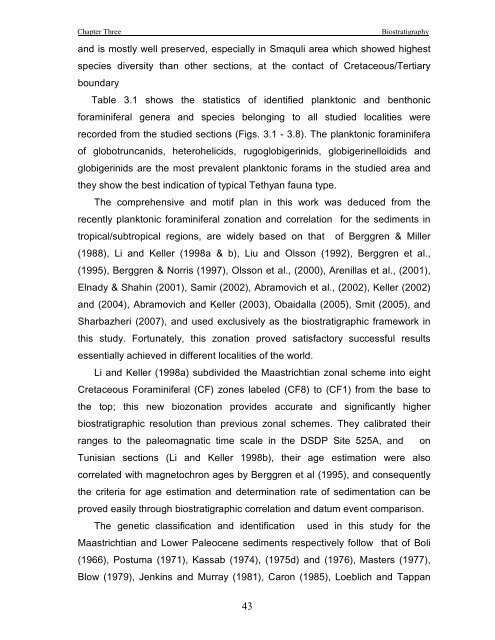biostratigraphy and paleoecology of cretaceous/tertiary boundary in ...
biostratigraphy and paleoecology of cretaceous/tertiary boundary in ...
biostratigraphy and paleoecology of cretaceous/tertiary boundary in ...
You also want an ePaper? Increase the reach of your titles
YUMPU automatically turns print PDFs into web optimized ePapers that Google loves.
Chapter Three Biostratigraphy<br />
<strong>and</strong> is mostly well preserved, especially <strong>in</strong> Smaquli area which showed highest<br />
species diversity than other sections, at the contact <strong>of</strong> Cretaceous/Tertiary<br />
<strong>boundary</strong><br />
Table 3.1 shows the statistics <strong>of</strong> identified planktonic <strong>and</strong> benthonic<br />
foram<strong>in</strong>iferal genera <strong>and</strong> species belong<strong>in</strong>g to all studied localities were<br />
recorded from the studied sections (Figs. 3.1 - 3.8). The planktonic foram<strong>in</strong>ifera<br />
<strong>of</strong> globotruncanids, heterohelicids, rugoglobiger<strong>in</strong>ids, globiger<strong>in</strong>elloidids <strong>and</strong><br />
globiger<strong>in</strong>ids are the most prevalent planktonic forams <strong>in</strong> the studied area <strong>and</strong><br />
they show the best <strong>in</strong>dication <strong>of</strong> typical Tethyan fauna type.<br />
The comprehensive <strong>and</strong> motif plan <strong>in</strong> this work was deduced from the<br />
recently planktonic foram<strong>in</strong>iferal zonation <strong>and</strong> correlation for the sediments <strong>in</strong><br />
tropical/subtropical regions, are widely based on that <strong>of</strong> Berggren & Miller<br />
(1988), Li <strong>and</strong> Keller (1998a & b), Liu <strong>and</strong> Olsson (1992), Berggren et al.,<br />
(1995), Berggren & Norris (1997), Olsson et al., (2000), Arenillas et al., (2001),<br />
Elnady & Shah<strong>in</strong> (2001), Samir (2002), Abramovich et al., (2002), Keller (2002)<br />
<strong>and</strong> (2004), Abramovich <strong>and</strong> Keller (2003), Obaidalla (2005), Smit (2005), <strong>and</strong><br />
Sharbazheri (2007), <strong>and</strong> used exclusively as the biostratigraphic framework <strong>in</strong><br />
this study. Fortunately, this zonation proved satisfactory successful results<br />
essentially achieved <strong>in</strong> different localities <strong>of</strong> the world.<br />
Li <strong>and</strong> Keller (1998a) subdivided the Maastrichtian zonal scheme <strong>in</strong>to eight<br />
Cretaceous Foram<strong>in</strong>iferal (CF) zones labeled (CF8) to (CF1) from the base to<br />
the top; this new biozonation provides accurate <strong>and</strong> significantly higher<br />
biostratigraphic resolution than previous zonal schemes. They calibrated their<br />
ranges to the paleomagnatic time scale <strong>in</strong> the DSDP Site 525A, <strong>and</strong> on<br />
Tunisian sections (Li <strong>and</strong> Keller 1998b), their age estimation were also<br />
correlated with magnetochron ages by Berggren et al (1995), <strong>and</strong> consequently<br />
the criteria for age estimation <strong>and</strong> determ<strong>in</strong>ation rate <strong>of</strong> sedimentation can be<br />
proved easily through biostratigraphic correlation <strong>and</strong> datum event comparison.<br />
The genetic classification <strong>and</strong> identification used <strong>in</strong> this study for the<br />
Maastrichtian <strong>and</strong> Lower Paleocene sediments respectively follow that <strong>of</strong> Boli<br />
(1966), Postuma (1971), Kassab (1974), (1975d) <strong>and</strong> (1976), Masters (1977),<br />
Blow (1979), Jenk<strong>in</strong>s <strong>and</strong> Murray (1981), Caron (1985), Loeblich <strong>and</strong> Tappan<br />
43

















